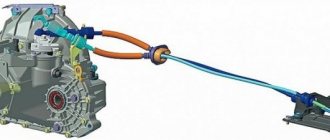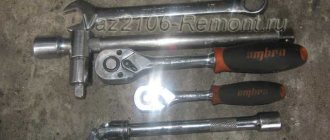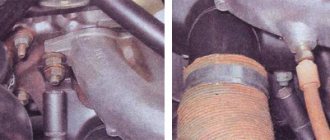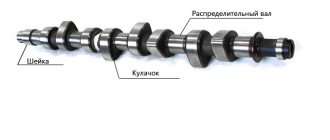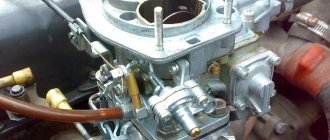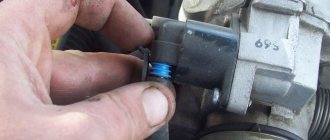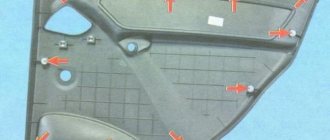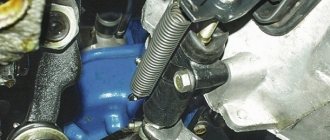Operating principle of variable geometry collectors
Transformation of the intake manifold in practice can be implemented by two methods: changing the cross-sectional area and changing its length. These methods can be used individually or in combination.
We recommend: Filling and lubrication work
Variable Length Intake Manifold Features
Variable length intake manifold
The technology of changing the length of the intake manifold is used for cars with engines running on both gasoline and diesel, with the exception of supercharged systems. The operating principle of this design is as follows:
- When the engine load is low, the air travels a long way.
- At high engine speeds - short.
- Changing the operating mode is carried out by the engine ECU through a drive that switches the valve between two branches of the manifold.
The operation of the variable length intake manifold is based on obtaining a resonant boost effect. It provides intensive air injection into the combustion chamber. This happens as follows:
- After all intake valves are closed, some air remains in the manifold.
- Oscillations of residual air occur in the manifold pipe, proportional to the length of the intake manifold and the engine speed.
- When these vibrations reach resonance, high pressure occurs.
- When the intake valve opens, injection occurs.
For supercharged engines, this type of intake manifold is not used due to the absence of the need to create resonant boost. Air injection in such systems is carried out forcibly by a pre-installed turbocharger.
Features of the variable-section intake manifold
Variable-section intake manifold
In the automotive industry, changing the cross-section of the intake manifold is used on vehicles equipped with engines running on both gasoline and diesel, including systems equipped with supercharging. The smaller the cross-section of the pipeline through which air is supplied, the higher the flow speed, and therefore the mixing of air and fuel. In such a system, each cylinder has two intake ports equipped with their own intake valves. One of the pair of channels has a damper. The drive of such a system for changing the geometry of the intake manifold is carried out by an electric motor or a vacuum regulator. The operating principle of the design is the following process:
- When the engine is running at low speeds, the valves are in the closed position.
- When the intake valve opens, the air-fuel mixture (air) enters the cylinder through only one channel.
- When supplied through one channel, the air flow enters the chamber in a spiral, providing better mixing with the fuel.
- When the engine operates at high speeds, the dampers open and the air-fuel mixture (air) flows through two channels, which increases engine power.
How does the manifold affect engine performance?
When the engine operates at maximum speed with the gas pedal fully depressed, the speed of air in the manifold approaches (and in sports cars noticeably exceeds) the speed of sound. At such speeds, any turn and the slightest bump turn out to be a serious obstacle, which greatly increases the resistance of the collector to air flow. As a result, less air enters the cylinders, so engine power drops. In this mode, the carburetor often produces an over-lean mixture, the burning rate of which is tens of times faster than normal. Therefore, the air-fuel mixture explodes, which leads to damage to valves, pistons and other engine elements.
Equally important is a high-quality connection between the manifold and the carburetor or. If the sealing elements are worn out or the fastening nuts are poorly tightened, then air leaks occur at the contact point, resulting in an over-lean mixture and explosions in the combustion chamber.
Types of intake manifolds
There are the following types of intake manifolds:
- steel;
- aluminum;
- plastic;
- with variable geometry;
- with exhaust gas control valves (EGR);
- turbocharged;
- with point fuel injection, etc.
On modern engines, manifolds with point fuel injection are quite common. In this modification, fuel is supplied using electromagnetic injectors installed in each of its pipe-channels.
Schematic diagram of an intake manifold with point fuel injection
The intake manifold, like the engine as a whole, operates productively within a certain speed range. The design and type of installed manifold depends on the layout of the cylinder block, on the target orientation of the engine and on design solutions in general.
All of the above collectors are divided into two groups:
- single-plane;
- two-plane.
A single-plane manifold supplies the air-fuel mixture through one common channel, while a multi-plane manifold initially divides the mixture flow into two streams.
Single plane manifold
Typically, engines with dual-plane manifolds produce more power at low and mid-range speeds between 2000-4000 rpm. At high levels, the power will be slightly lower due to the turbulence formed.
This is interesting: Technical characteristics of 4JG2 3 l/120 l. With.
Dual-plane manifold
A manifold with a common chamber without partitions reveals its potential at speeds of 5000 and above.
Installing an intake manifold of a different modification does not guarantee improved engine performance. Usually such parts are designed together with it.
Engineering variations on the theme of reservoirs
Despite its simplicity, the exhaust manifold has varieties, the appearance of which is due to the physics of gas circulation through pipes.
Because of this, developers have to make compromises, and we will definitely talk about them. But first, the varieties.
The following types of collectors are found:
In the first case, the design turns out to be very cheap.
Its main feature is short outlet pipes and a common collection chamber. To be honest, one-piece manifolds are extremely ineffective for exhaust gas removal.
This is due to short tubes, due to which the influence of gas pulses on neighboring cylinders is great.
As a result, we have unsatisfactory purging of the combustion chambers, and this is reflected in many factors, including engine parameters.
In order for the engine to operate at maximum efficiency, tubular exhaust systems were developed.
They are the ones most often found under the hoods of modern cars.
They are exhaust pipes coming from the cylinders and converging into one (or sometimes first into several, and then into one).
When developing them, engineers have a lot to tinker with, since the engine output at different speeds depends on the length of the exhaust pipes and their diameter.
So, for example, if we take short tubes, then, thanks to the resonance effect, they will best ventilate the combustion chambers at high speeds.
But then the mutual influence of the cylinders on each other will increase.
Long exhaust pipes, in turn, are good at low speeds.
The story is similar with the diameter - a small pipe diameter is optimal from the point of view of the speed of gas removal at low and medium speeds.
But they experience a lot of resistance at high speeds, which is why the engine power drops. With larger diameter exhaust pipes the opposite is true.
Thus, engineers have to maneuver and look for compromises, which we mentioned earlier for good reason.
Why might you need to repair the intake manifold?
At its core, the intake manifold has a rather complex design. Based on these considerations, the likelihood of breakdown or malfunction of a certain individual element of the entire device increases significantly. Dampers often fail (mainly on German car brands).
In this case, the car becomes very weak and significantly loses power. At the same time, fuel consumption increases significantly, and traction and engine performance generally deteriorate. Manifold flaps fail for several reasons: low-quality material used to make these flaps, too high a temperature, and the presence of oil condensate.
In addition, the control valve for these intake manifold flaps may also fail. A sign that oil consistency has entered the intake manifold is its increased consumption, which can exceed 1 liter per 1 thousand km.
In parts that are made of plastic, you can often encounter a problem that involves disconnecting the tube from the swirler. This, in turn, gives rise to a certain characteristic sound during actual movement: noise and crackling in the car. This breakdown can be completely solved even with your own hands.
We recommend: What is better to choose between a CVT, manual, automatic and robotic gearbox
In addition, air leaks may occur in the intake manifold itself. This breakdown may affect the vehicle's power. But the most important thing is that there will be a serious noise that resembles suction or blowing.
In automotive nature, there is a special sensor that is used to measure the absolute pressure in the intake manifold. This sensor, in addition to the above function, is responsible for optimizing combustion processes and the formation of a mixture of air and fuel. If this sensor fails, then most likely the electronic control unit will begin operating in emergency mode.
Sometimes it happens that the engine cannot be started at all. The design of the modern sensor, located in the intake manifold, is quite reliable. And yet, malfunctions in it are possible.
Manifold tuning
Engine tuning is a whole range of work to refine its individual components and parts. The intake manifold can also be modified to improve engine performance.
Tuning this part has two directions:
- to overcome the negative influence of its form;
- for finishing the internal surface.
What does form have to do with it?
The flow of air or working mixture in the manifold is uneven due to its shape. If the manifold is asymmetrical, then the largest amount of air or fuel-air mixture will enter the first cylinder, and less will enter each subsequent one. The symmetrical one also has a drawback: there, the largest amount of air enters the middle cylinders. In both cases, the cylinders operate unevenly on mixtures of different qualities. As a result, engine power decreases.
Tuning, in this case, involves replacing the standard intake manifold with a multi-throttle intake system. Its design is such that the air flows supplied to the cylinders are independent of each other, since each of the cylinders is equipped with its own throttle valve.
"Internal" work
If there is a lack of funds, tuning can be done more cheaply, almost for nothing. Inside the reservoirs there are almost always a large number of irregularities and tides, and the surface is rough. All together, this causes unnecessary turbulence that interferes with the quality filling of the cylinders. During measured driving, this phenomenon is almost unnoticeable, but if you want to achieve greater efficiency from the engine, you need to fight these shortcomings.
Tuning a standard intake manifold involves grinding its inner surface in order to remove tides and roughness. You need to grind not until a mirror appears, but only until the entire surface is uniform. If you overdo it, drops of fuel will condense on the walls and tuning will give a completely opposite result.
Finally, in order for the tuning to be as complete as possible, you need to pay attention to the interface between the manifold and the cylinder head. Often, a step remains in this place, interfering with the normal flow of air flow, which must be eliminated (this is where cylinder head tuning begins).
In the power supply system of any internal combustion engine, the intake manifold plays a serious role. It conveys the air or air-fuel mixture to the cylinder head, from where it enters the combustion chamber. The more, the greater the amount of air (mixture) passes through the intake manifold and the stronger its influence on engine parameters.
Geometry changing systems from various manufacturers
In the global automotive industry, the system for changing the geometry of the intake manifold is used by many manufacturers, who designate the technology with their own unique name. Thus, designs with switching the length of the intake manifold can be designated as:
- Dual-Stage Intake in Ford vehicles;
- Differential Variable Air Intake for BMW cars;
- VICS or VRIS in Mazda cars.
In turn, the mechanism for changing the cross-section of the intake manifold can be labeled as:
- IMRC or CMCV in Ford vehicles;
- Twin Port for Opel cars;
- Variable Intake System in Japanese Toyota cars;
- Variable Induction System for the Volvo brand.
The use of a geometry changing system, regardless of whether the length of the intake manifold varies or the cross-section, allows you to increase the power of the car, makes it more economical and reduces the concentration of toxic components in the exhaust gases.
( 4 ratings, average: 5.00 out of 5) Loading…
Shape and volumetric efficiency
One of the most important parameters of the intake manifold that determines its efficiency is its shape. The basic rule that all engineers adhere to is that the intake manifold should not have any angular shapes , as this will provoke pressure drops and, as a result, worse filling of the cylinders with air or working mixture. Therefore, all collectors have smooth transitions between segments and rounded shapes.
The vast majority of current collectors use runners. They are separate pipes diverging from the central entrance of the manifold to all available intake channels in the cylinder head. Their task is to use a phenomenon called Helmholtz resonance. The operating principle of the design is as follows.
At the moment when suction occurs, air flows at a very high speed through the open inlet valve. When the valve closes, the air that did not have time to enter the cylinder retains a large impulse, which means it presses on the valve, resulting in a high-pressure zone. Then pressure equalization occurs, with lower pressure in the manifold. Due to the influence of inertial forces, leveling occurs with fluctuations: first, air enters the runner at a pressure lower than in the manifold, then at a higher one. This process occurs at the speed of sound, and before the intake valve opens again, oscillations can occur many times.
Article on the topic: Where does the water in the carburetor come from?
The smaller the diameter of the runner, the greater the change in pressure due to resonant air vibrations. As the piston moves down, the pressure at the outlet of the runner decreases. This low pressure pulse then travels to the manifold inlet where it turns into a high pressure pulse that travels in the opposite direction through the runner and valve, after which the valve closes.
To achieve the maximum effect from resonance, the intake valve must open at a strictly defined moment, otherwise the result will be the opposite. This is quite difficult to achieve. The gas distribution mechanism is a dynamic unit, and its operating mode is directly dependent on the crankshaft speed. The pulses are synchronized statically, the synchronization depends on the length of the runners. The problem is partially solved by selecting the length for a certain speed range at which the greatest torque is achieved. Another option is the use of systems for changing the geometry of the intake manifold and electronic timing control.
Variable geometry intake manifolds
The system for changing the geometry of the intake manifold deserves special attention.
Engines with variable intake tract length
Pulsing movements in the intake manifold certainly helps its operation, but the process only starts within a range of certain vibration frequencies. The pulse length is proportional to the length of the collector pipe. This principle is used in variable-length intake manifolds. The electronic engine control unit controls the speed and sends a signal to the valve to turn on the “small” or “large” mixture supply circle.
Design of collectors with changing channel cross-sections
If the cross-section of the intake manifold changes along the direction of movement of the fuel mixture, dampers are installed, which in the closed position do not completely block the flow of the mixture, but reduce the clearance of the manifold. A change in the flow cross-section leads to turbulence and an increase in its speed. Such devices are controlled by an on-board computer.
An example of the implementation of a manifold with a variable cross-section for diesel and gasoline engines
Intake manifolds with exhaust gas recirculation system
Intake manifolds with EGR Exhaust Gas Recirculation systems are designed to reduce toxic emissions into the atmosphere. Similar manifold designs are installed on both gasoline and diesel engines. The principle of operation is simple - exhaust gases from the exhaust system flow back into the intake manifold through a separate valve, which reduces the oxygen content in the air-fuel mixture, which means the intensity of oxidation and the temperature in the combustion chambers are reduced. The system turns on only in certain modes, for example, at idle.
The value of the length and shape of the intake manifold pipes
Recently, great importance has been attached to the length and shape of the intake manifold pipes or channels. Sharp curvatures and sharp corners are unacceptable in the channel design, since in these places fuel mixed with air will inevitably settle on the walls. Modern manifolds use a principle born in the depths of sports car workshops - all individual channels of all cylinders, regardless of the distance from the center, are of equal length. This design helps combat the so-called “Helmholtz resonance”. The flow of the fuel-air mixture at the moment the intake valve opens moves along the manifold channel towards the cylinder at a significant speed. When the valve closes, the air that has not had time to pass into the combustion chamber continues to press against the closed valve, creating an area of high pressure. Under its influence, the air tends to return back to the upper part of the collector. Thus, a counterflow is formed in the channel, which stops the moment the valve opens next time. The process of changing the flow direction in traditional reservoirs occurs constantly and at a speed close to supersonic. The fact is that in addition to the opening and closing of valves, the air tends to constantly change direction in accordance with the phenomenon of resonance, which was discovered by Hermann von Helmholtz, the author of classical works on acoustics. Naturally, when the air continuously “hangs back and forth”, power losses are inevitable. For the first time, manifolds optimized for Helmholtz resonance were used in Chrysler V10 engines, which were equipped with cars and pickups. The design was subsequently adopted by other manufacturers.
We remove the manifold ourselves
Initially, any car enthusiast, in order to begin replacing or repairing this part, needs to know how to dismantle the intake manifold. In general, this procedure is not complicated and can be completed by one person in ten minutes. First you need to find the fuel pump and remove the fuse from it, after which you need to start the engine. The pressure in the system will drop significantly, and in the near future the engine will stall.
After the procedure, you can disconnect the battery and remove the decorative casing from the motor itself. After this, it is necessary to remove the pipes from the air filter and remove it. Afterwards, you should unscrew the throttle assembly. It is important to note that you should not touch the damper fasteners to avoid damaging them. That's it, the collector is before my eyes.
In some cases, the square tubes peel off. Then you will need to drill two holes in the collector itself so that through these holes you can get to this tube. After this, you need to screw the screws into these holes and secure it. The control valve and dampers cannot be replaced or repaired separately. This is why you should buy and install a completely new part. If the cause of the breakdown is the sensor, then the element that has failed needs to be replaced.
Intake manifold length control solenoid valve
The valve consists of a body, a locking mechanism, three fittings and an electromagnetic coil. To remove the valve from the car, just bend the latch on the receiver side and slide the valve down
The valve has three fittings. One of them (atmospheric) is closed with a lid. It must be removed to check and remove dirt.
To check the valve's closing properties, simply blow into the side fitting. In this case, the air should go out into the lower (atmospheric) fitting, but not into the upper one. If you apply voltage to the valve, then everything should be the other way around.
To check the valve winding, just press the clamp of the wire block and remove it
There will be two contacts visible on the valve. You need to connect an ohmmeter to them and measure the resistance, which should be several ohms. If the resistance is normal and the valve does not work, then you need to check the incoming voltage at the block, which should be about 12 V. Don't forget to start the engine to measure the voltage.

